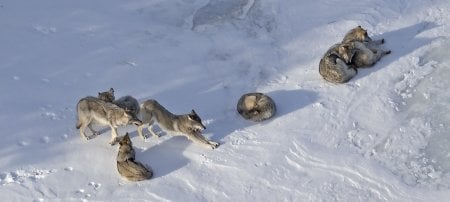Isle Royale National Park, Michigan Tech Celebrate 50 Years of Wolf-Moose Research
It’s not your ordinary 50th anniversary. Scientists, National Park Service personnel, environmentalists, politicians and the public are gathering at Isle Royale National Park on July 25-27 to celebrate 50 years of research on the wolves and moose of Isle Royale.
The Michigan Technological University study is the longest-running continuous predator-prey study ever conducted anywhere.
During the gala weekend celebration, some of the scientists who have led the study—Rolf Peterson, John Vucetich, L. David Mech and Doug Smith—will talk about their 50 years of research and answer questions.
Peterson and Vucetich, wildlife ecologists at Michigan Tech, now head the research. Mech, a senior scientist with the Biological Resources Division of the US Geological Survey, worked on the project with Purdue University wildlife ecologist Durward Allen at its inception in 1958. Smith, who recently headed the re-introduction of gray wolves into Yellowstone National Park, participated in the Isle Royale research from 1979 to 1992.
A film four years in the making, Fortunate Wilderness, will have its world premier at the Rock Harbor Auditorium on Isle Royale on July 25. George Desort, an independent filmmaker from the Upper Peninsula of Michigan, produced the documentary, which is slated for showings in Houghton, Mich., and Duluth, Minn., during coming months. For a preview of the film, see https://www.isinglasspictures.com/.
A capacity crowd of close to 300 people is expected to participate in the weekend celebration at the isolated island National Park in northwestern Lake Superior, but anniversary outreach efforts are reaching thousands more.
Michigan Tech scientists Peterson and Vucetich have presented numerous public programs, including one in Washington, DC and one in New York, and more are scheduled for the fall. A celebration of the wolf-moose study anniversary is scheduled for November 3-7 in Duluth, Minnesota, featuring public talks and school programs by researchers and National Park staff.
The Carnegie Museum in Houghton, Mich., is featuring an exhibit about Isle Royale through September 2008, and the Isle Royale Natural History Association sells wolf-moose books, posters, pins, T-shirts and sweatshirts.
Nearly 100 teachers from Michigan, Wisconsin, Illinois, Minnesota and New York have participated in summer workshops on Isle Royale, sponsored by the Isle Royale Institute at Michigan Tech, whose staff also presented at two teachers’ conferences and updates teaching resources regularly to a mailing list comprising all science and math teachers in Michigan, Wisconsin and Minnesota.
News media including Scientific American, Washington Post, Detroit Free Press, Duluth News-Tribune, Audubon magazine and Associated Press (AP) wire service have reported on the Isle Royale wolf-moose research. AP stories are published in newspapers around the world. Web sites with more information about the Isle Royale wolf-moose study include www.wolfmoose.mtu.edu and www.isleroyalewolf.org/wolfhome/home.html.
A consortium of educational, governmental and natural resources organizations has led the year-long effort to celebrate and publicize the wolf-moose study. They include:
* National Park Service/Isle Royale National Park
* Michigan Technological University
* Isle Royale Institute
* Isle Royale Natural History Association
* International Wolf Center
* Timber Wolf Alliance
* University of Minnesota–Duluth
* Great Lakes Research and Education Center
* Michigan Department of Natural Resources
* Minnesota Department of Natural Resources
* Northland College
* Wisconsin Department of Natural Resources
* U.S. Department of Agriculture Forest Service
* Discovery World, Milwaukee
--------------------------------------------------------------
Isle Royale Wolf-Moose Predator-Prey Study: Facts at a Glance
Isle Royale is located in northwestern Lake Superior. It is 45 miles long and 9 miles wide. The National Park boundary extends 4.5 miles into the lake and encompasses hundreds of small islands.
Motor-driven vehicles or bicycles are not permitted on Isle Royale. Access to the island is by boat or seaplane only.
Isle Royale is home to a population of wolves and moose. The wolves are the sole predator of the moose, and moose make up approximately 90 percent of the wolves’ diet.
The wolves are believed to have crossed to Isle Royale from Canada on an ice bridge around 1950. It is not known for certain how the moose got there, although it is believed that they swam to the island in the early 1900s.
Scientists have been studying the wolves and moose of Isle Royale continuously since 1958. The island’s size and distance from the mainland makes it an ideal natural ecology laboratory.
The Isle Royale Wolf-Moose Predator-Prey study is supported by Michigan Technological University, the National Park Service. the National Science Foundation and the Earthwatch Institute.
Canine parvovirus, contracted from an infected visiting dog, nearly wiped out the wolves of Isle Royale in the early 1980s.
An unusually severe winter in 1995-96 caused a major moose die-off.
1998 ushered in a period with unusually warm summers, reducing opportunities for moose to feed in summer and aiding moose ticks, a problematic parasite. This situation continues today.
Isle Royale National Park is the setting for two novels by mystery writer and former park ranger Nevada Barr.
Michigan Tech wildlife ecologist Rolf Peterson and his wife, Candy, raised two sons in historic Bangsund Cabin, a Norwegian fishermen’s cabin on Isle Royale, without electricity or running water.
With the help of Earthwatch volunteers, Peterson has collected bones and antlers from more than 4,500 moose, the largest collection in the world.
Research on moose bones holds promise for greater understanding of the relation of arthritis to nutrition.
Michigan Technological University is a public research university founded in 1885 in Houghton, Michigan, and is home to more than 7,000 students from 55 countries around the world. Consistently ranked among the best universities in the country for return on investment, Michigan’s flagship technological university offers more than 120 undergraduate and graduate degree programs in science and technology, engineering, computing, forestry, business and economics, health professions, humanities, mathematics, social sciences, and the arts. The rural campus is situated just miles from Lake Superior in Michigan's Upper Peninsula, offering year-round opportunities for outdoor adventure.




Comments